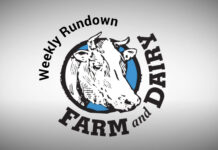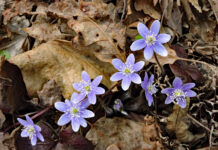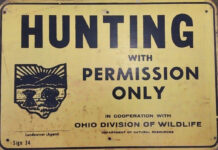Ohio’s spring turkey season wrapped up May 26, and the Division of Wildlife has released the number of turkeys taken. Hunters are required to record their turkey harvest using Ohio’s game check system, which allows the division to track the turkey-take.
The total number represents all birds checked from April 20 to May 26 and includes the 1,785 taken during the two-day youth season which was held from April 13-14. A total of 15,673 were reported, beating the 14,030-bird three-year average for the season.
The top 10 counties for bagging a wild turkey this season were Ashtabula (470), Belmont (454), Tuscarawas (449), Monroe (447), Washington (410), Gallia (400), Muskingum (397), Trumbull (396), Meigs (381) and Columbiana (377).
Following above-average brood production summers in 2021 and 2022, biologists expected a high proportion of adult birds in the total harvest this spring. Their informed prognostication proved correct with adult male turkeys making up 82% of the final count with 12,778 big gobblers taken, and 2,595 juvenile male turkeys (jakes), representing 17% of birds taken.
You don’t need to be a math whiz to figure out that those two numbers don’t add up to the division’s grand total. Some mistakenly believe that the season is for male turkeys only. While the results would suggest this, a legal turkey during the Ohio spring season is legally described as a turkey with a visible beard — a sort of turkey chest hair.
Bearded ladies
Actually, that beard is not hair like you’d find on grandpappy’s chin. It’s really a plume of dark brown or black feathers that protrude from the bird’s chest, feeling a bit like a miniature horsetail. It’s commonly found on the male of the species and is believed to be one of the judgment points that declare a particular turkey’s dominance in its realm. There is a bit of a catch — genetics sometimes allow a beard to sprout on a hen which then makes that bird fair game during the hunting season.
Research has indicated that the beards may be found on about 10% of the hen population, though it’s just about always shorter and stubbier looking next to even a young jake gobbler’s whiskery feathers. Regardless, it kind of ends up being an unlucky adornment. While some hunters will pass on a bearded hen (experience of the hunter is a tell), some take the bird realizing its novelty, while others feel lucky just getting a seasonal turkey. Nobody can tell the difference at the dinner table.
Status symbol
Those who hunt the big birds view the turkey’s beard much like deer hunters value a buck’s antlers, and there’s good reason. Both are indicators of diet, health and stealthy longevity. Like buck deer and their antlers, young male turkeys begin growing that beard early in their life — about three months. Unlike the deer, which shed their antlers and need to wait all summer for a new and improved set to grow back, turkeys don’t lose their beard. They just keep on growing.
In fact, that growth rate can be a good indicator of the approximate age of the gobbler. Wildlife biologists tell us that a male turkey’s beard can grow about five inches each year. This means that a less than one-year-old jake will likely have something less than five inches while a third-season bird can begin having double-digit length beards.
Matt DiBona, a wildlife biologist for the National Wild Turkey Federation, believes that anything over 10 inches is a really nice beard. As the name implies, the NWTF is wild about wild turkeys and maintain a professional influence with many state conservation agencies. They also keep track of such things as big beards through admissions on their website. The longest individual beard they’ve recorded is 11.75 inches, probably a three- to four-year-old bird.
Contrary to what some might think, life isn’t easy for turkeys and living long enough for a 12-inch beard is doing well. In fact, most wild turkeys will never see a fifth birthday.
Then there are the overachievers. Some turkeys can’t settle with one beard and may sport two or more. How many more? Once again, NWTF has reported a turkey with 13 beards. Normally, most multiple beards tend to have one main plume and the rest more like outlying stragglers — but that’s the norm. Each year, gobblers are taken that have true multiple, nearly equally thick beards. One tom on record grew multiple beards that if laid end-to-end, would have measured an astounding 26.5 inches. I imagine he had quite a dance card during his spring strut.
There are a few things that can affect the length and longevity of this plume of turkey pride. Many hunters have shot big gobblers with beards that look tattered around the bottom. Believe it or not, it’s not from sparing with other turkeys or a bad cut. It’s from dragging it on the ground during courtship strutting. The rockier or rougher the terrain, the more likely that they’re getting a trim. Poor diet and beard rot can also weaken the bird’s beard causing it to snap off.
How to tell
Next time you’re on a spring hunt for America’s favorite Thanksgiving guest and you shoot a bearded turkey, how can you be sure you haven’t shot Tina Turkey instead of Tom? It’s really pretty easy to find the truth rather quickly. Size usually matters. Adult toms can weigh in at 30-pounds while hens tend to be less than half of that. Next are the sharp and pointy spurs on a gobbler’s legs. These little blades are used by the males to defend their realm from interloping suitors looking to steal their hen harem.
The head and neck of a turkey are key features to differentiate the two sexes. A tom’s head is larger and is supported by a longer neck. It has a flap of skin called a waddle hanging underneath and a protuberance on its forehead called a snood which hangs over the male turkey’s face and bill. The waddle and snood are far more prominent in Toms than hens and, during spring breeding season, the snood and waddle can become quite colorful with lots of reds and blues. You know, if I get anymore bird dogs, I think I may have just discovered their names.
Finally, if you’re hunting turkeys and one of them puffs up, fans its tail and begins its woodland yodeling from 15-feet away — trust me, you’ll know it’s old tom. That’s the one I’ll be waiting for … the bearded ladies of the backwoods have nothing to fear from me.
“Desires dictate our priorities, priorities shape our choices, and choices determine our actions.”
— Dallin H. Oaks












